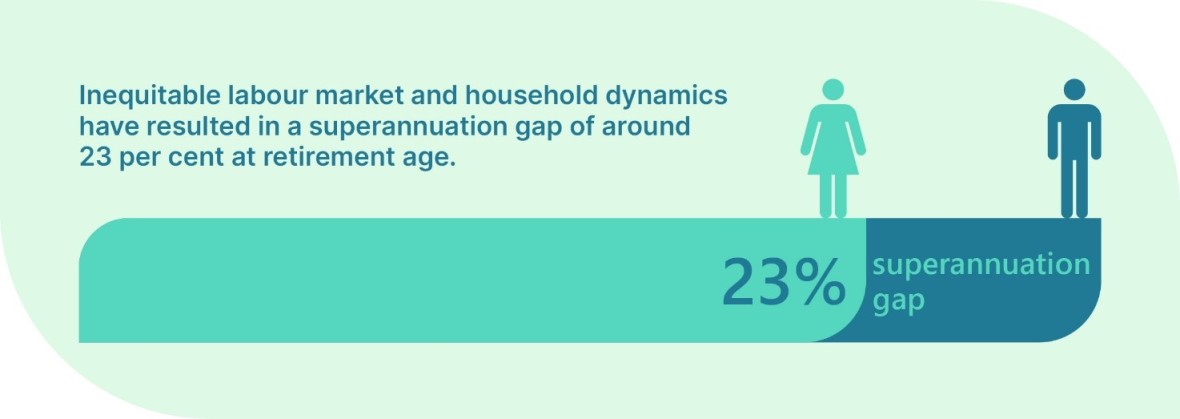The factors outlined in this paper impact us across the life course. They can be experienced in different ways at different times, and the impacts can accumulate over a life time.
Financial insecurity, for example, can impact a woman’s decision or options to leave a violent relationship. Violence can have devastating health impacts and diminish a woman’s capacity to participate in the workforce and progress in her career. Certain women’s health issues – such as endometriosis and menopause – can affect workforce participation. Time out of the workforce and the gender pay gap can have a cumulative impact on women’s lifetime earnings, with considerable implications for older women, including for retirement incomes.

Inequitable labour market and household dynamics have resulted in a superannuation gap of around 23 per cent at retirement age. At 60–64 years-old, men have $181,000 in superannuation, while women have $140,000.[35]
Housing and Infrastructure
Australia’s infrastructure and housing environment tend to be designed from an assumption that women and men have the same needs. However, the combination of the factors explored in this paper often result in particular challenges and needs for women in this area.
Housing is critical infrastructure, with access to affordable, safe and secure long-term housing delivering significant economic and social benefits. Housing is a key enabler of improved education and retirement outcomes, workforce participation, economic equality, safety, health and wellbeing. For those impacted by family and domestic violence, housing is key for their ability to leave and recover. Research has shown 25 per cent of women who wanted to leave a violent partner were unable to due to a lack of financial support.[36]
Australian’s are facing many household pressures, with rising rental costs and supply pressures that have built up over many years. Many women face additional challenges of finding safe and secure long-term housing. This is particularly evident for single women who don’t have the economic security of a dual income relationship, and who are most likely to become homeless. The cumulative impacts of gender inequality, including the gender pay gap and family and domestic violence, result in women being at increased risk of housing insecurity. Women are less likely to own a property than men. Many people on low incomes spend a large share of their income on rent, there is rising demand for social housing, with more people seeking help from homelessness services, and more people being turned away.[37]
Violence against women also has significant ramifications for women’s economic equality, with a 2011 national domestic violence and the workplace survey finding that 48 per cent of women who had experienced violence saying that it reduced their capacity to attend work.[38] Victims and survivors of sexual violence are up to 45 per cent more likely to experience high levels of financial stress than those who have not experienced sexual violence. KPMG modelling also estimates that nationally the cost of violence against women and their children is $26 billion each year, with victim-survivors bearing approximately 50 per cent of that cost.
Many women experiencing violence can also face a stark choice to stay in a relationship where violence is occurring or escalating, or to leave the relationship but face ongoing financial hardship, homelessness or poverty. There can be a range of reasons why women stay or leave, including because they want to try to work things out. Having no money or nowhere else to go are some of the reasons women identify for leaving a violent relationship, only to return to it later.[39]
Prompts
What are critical factors that exacerbate gendered disadvantage over the life course?
Are there issues you (or your organisation or community group) would address first? Are there issues that should be addressed together?
[35] Australian Tax Office (ATO) (2022) ‘Taxation Statistics 2019-20: Individual Statistics, ATO website, accessed on 25 August 2022.
[36] Summers A (2022) The Choice of Violence or Poverty
[37] Productivity Commission (2022) In Need of Repair: The National Housing and Homelessness Agreement, p 2.
[38] L McFerran, Safe at home, safe at work? National domestic violence and the workplace survey, University of New South Wales, 2011.
[39] The Commonwealth of Australia, 2022-23 Women’s Budget Statement, Budget October 2022-23.
